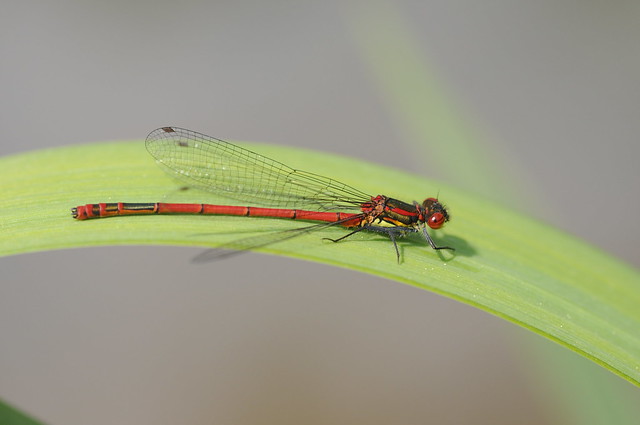 |
| © Cumbria Biodiversity Data Centre |
There are a few key things you need to do. Firstly, select the records you are going to use. For example, in this case I was looking at an adult flight period, so after exporting all the Cumbrian records of Large Red Damselfly from the CBDC Recorder 6 database to a spreadsheet, I did some work in Excel to filter out any non-adult records using the "record type" field; measurement fields; comments field etc. As I was interested in flight periods, I also needed to throw out records with vague dates such as July 2011 or Summer 2010: records with vague dates are useful for distribution maps, but not for phenology.
My aim was to see if there was any hint in the Cumbrian records of phenological change for this species. Now at this point I'd like to make clear that these were anecdotal presence records collected by lots of different people in lots of ways - and so a huge pinch of salt is needed. e.g Some recorders may be sending in their first and last sightings of each species only, making the recording pattern unrelated to the population pattern (well not unrelated but you know what I mean!).
Proper phenological studies (like the wonderful work by Tim Sparks and colleagues) usually use monitoring data with known sampling methods or take into account recording biases that may be involved. However, for a geeky person like me it is still fun to take a quick look at the data we have and see if it seems to contain any patterns - without judging whether this is due to real ecological change or just methodological change/recording biases.
I needed to derive some information from the dates of the records. I used the Excel function WEEKNUM to get the week number of every record date and the YEAR function to get the year of the record. There is no reason you couldn't use the day of the year instead if you wanted, instead of grouping to week.
Because I was interested in patterns over time, I also put each record in a decade group - again, an arbitrary decision. I did this in Excel using a pivot table with year as the Row, week as the Column, count of year as the Data and then grouping year into decades. As pre-1980 records are sparser I copied and pasted the results (as values) into another worksheet and summed all the historical decades. I then worked out the percentage of the total records in each decade group that had occurred each week.
I could now turn the bottom table into a bar chart in Excel - and this is as far I was going to go. But then someone pointed out that this was all a bit busy and hard to interpret and curves would be much easier on the eye - it was time to turn to some stats software…*
 |
| © Cumbria Biodiversity Data Centre |
And as a reward for staying to the end of part one, here is a pretty picture of the damsel in question:
 |
| (c) Thomas Bresson CC BY 2.0 Flickr |

No comments:
Post a Comment